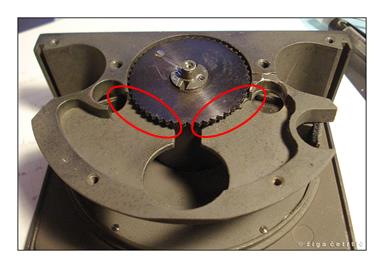KMZ FT-2 Camera Servicing
Despite not posting anything for a while, it doesn't mean I lost interest in repairing cameras. I've done some repairing tasks that are already well covered over the web in the meantime.I have some psychological problems with opening quite rare cameras from my collection that are in a remarkably good shape. I'm always afraid I'll hurt them due to lack of experience and knowledge. But the time has come: the FT-2 panoramic camera sat on my shelf despite it wasn't fully operational for too long.
The Camera
Born in Krasogorsk in the famous KMZ factory, FT-2 is the first Soviet mass produced panoramic camera. The production numbers are quite low by the communist standards at less than 17 000 units, however, this is a special camera in many ways. It isn't obvious that its a camera at a first glance due to a strange user interface and form.FT-2 is a swing lens panoramic camera. When the shutter release is pressed, the lens rotates and draws image to the film thru a moving slit. To achieve different shutter speeds it uses variable rotation speeds (Horizont, its successor, uses variable slit width instead). The swing speed is selected with two small levers, film advance and shutter cocking is separate. There is a nice bubble leveler on the top and an unpractical and far from precise finder. Altogether the camera looks really complicated from the outside. True state of the art product.
The Specifications
- Industar-50 50 mm F/5
- Fixed focus
- Fixed aperture
- Shutter speeds: 1/400, 1/200, 1/100 s
- Frame size: 24×110 mm
The Problem
My FT-2 worked only at 1/100 s. 1/400 of a second smashed the turret like crazy and 1/200 was stuck. Later, when I opened the camera, I learned that 1/400 actually works as it should, but it still hurts me a little bit when I use this setting.The Service
As much as I was afraid getting inside this little fellow (yes, you may have an impression that FT-2 is a much bigger camera than it really is) it is an extremely simple apparatus to work on. At least as deep as I needed to go.I suggest you set the 1/400 s with the levers. Remove the screw that holds the shutter cocking handle in its place and remove it completely.
Remove the six screws on the top plate- Two screws are evidently bigger and longer, however, marked in the image below. There is the seventh screw on the top plate but we don't need to remove it.
The top plate can be removed from the main camera. Jiggle it a bit if it doesn't come off easily.
Turning the top plate around shows how simple FT-2 construction is. There are two worms with different pitch that are in fact brakes. Below the brake is released on the first and set on the second photo.
Each speed selection lever couples the corresponding worm brake with the main drum gear. The combination of the lever setting not shown on the FT-2 plate is in fact a state where both brakes are applied to the drum. I believe in that case the 1/200 s brake has no significant effect on the turret speed. On the photo below position of the brakes is marked with red circles.The snail on one break didn't turn and thus the 1/200 s setting didn't work. To remove the break from the casing unscrew the lever.
There is a washer between the screw and the lever.
To release the tension on the worm a screw should be removed from the break part, but the screw has a very small stop screw that I almost missed. First remove the stop screw located on the bottom...
... and then the bigger screw that actually holds the worm.
The worm doesn't go apart from the holder. It looks like the worm's axis is tightly nested to the holder and brushed in. I just soaked everything in a white spirit, additionally cleaned parts I was able to reach and added some WD-40. Despite it turned freely, there was still some significant friction between the worm and the toothed drum once mounted to the camera. Little grease applied to the worm solved the problem.
The Result
I screwed the test roll with not screwing enough. The FT-2's frame counter is directly coupled to the film sprocket holes. I figured out that one rotation of the frame counter can't be enough for the long negative the camera produces, but I thought two should do. Wrong. The frame counter needs to do three full turns in order to avoid overlapping.But, my friends, FT-2 rocks. I love Horizont outcomes, but this even longer negatives have such a great perspective my eyes got wet. Since there is no banding, lubrication did it's job.
The image below is the 100% crop from the above photo to show the detail FT-2 is capable to capture.
I'm an enthusiast collector of vintage cameras that likes to use them and tries not to spend a lot of money for his hobby. I'm not educated in camera servicing and I have little experience. So if someone that reads this has any comment or suggestion about what I did (wrong) or I should do, please, write a comment.

















